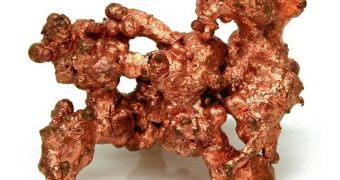Researchers at the United States Geological Survey (USGS) have recently completed the first-ever global assessment of undiscovered and unexploited copper resources. The investigation, based on a wealth of geological data, estimates that Earth contains around 3.5 billion tons of copper.
The document also features a list of 225 areas in 11 regions of the world that are believed to hold the highest concentrations of this critically-important element. Copper is used for wiring, cables, electronics, antimicrobial and antibiofouling applications and folk medicine, among others.
Based on current consumption rates, Earth has enough copper to satisfy human demands for around 150 years. This is a very short time frame, which should raise questions about what type of chemical will have to be used instead of copper in the future. At this point, South America holds the best position in terms of producing this element.
Additionally, the continent also features the highest amount of yet-undiscovered, unexploited copper reserves, so its economic position over the next century is likely to improve considerably. High potentials for undiscovered copper also exist in numerous areas of Asia, but particularly in China. The latter currently holds a monopoly over rare-Earth element production right now.
“This ground-breaking USGS assessment of future copper resources identifies a huge potential supply that is roughly six times greater than all the copper mined throughout human history,” explains Anne Castle, the US Interior Assistant Secretary for Water and Science.
“If enough of this copper can be developed in an environmentally responsible and economical way, it will be a boon to new manufacturing and other initiatives that rely on the availability of copper such as the Administration's energy efficiency initiative,” she adds. Humans first started using copper around 10,000 years ago, and have continued doing so ever since.
Current statistics estimate that the world consumes roughly 20 million metric tons of copper per year. The United States alone uses up some 2 million metric tons of copper annually. “Copper has become so valuable that it is even being stolen from construction sites and out of backyards,” says USGS Mineral Resources Program Coordinator, Larry Meinert. According to a study published in the journal Nature in 2003, this chemical is present in Earth's crust at a concentration of roughly 50 parts per million (ppm), either as native copper, or as minerals. The latter includes copper sulfides (such as chalcopyrite and chalcocite), copper carbonates including azurite and malachite, and cuprite, a copper oxide mineral/
“Copper is one of the building blocks of civilization and is used in almost every aspect of modern life such as plumbing, electrical wiring, cars, cell phones, and energy systems such as wind turbines,” Meinert concludes.

 14 DAY TRIAL //
14 DAY TRIAL //